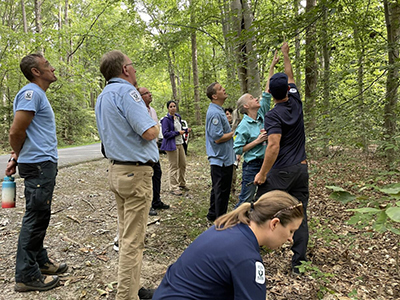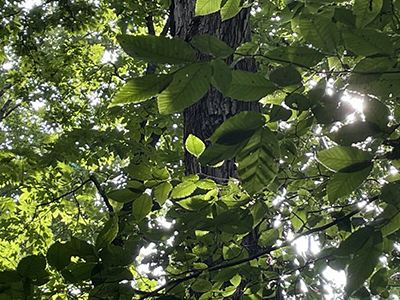~Urban Forest Management Division Monitoring Transmission & Educating Public~
 FAIRFAX COUNTY, Va. – The new beech leaf disease (BLD) is spreading rapidly, and young American beeches may end up succumbing to the threat in the forests around Fairfax County. After reading an article about the pest featuring an interview with a County arborist, staff from the Architect of the Capital in Washington, and the National Arboretum met with County urban foresters to learn more.
FAIRFAX COUNTY, Va. – The new beech leaf disease (BLD) is spreading rapidly, and young American beeches may end up succumbing to the threat in the forests around Fairfax County. After reading an article about the pest featuring an interview with a County arborist, staff from the Architect of the Capital in Washington, and the National Arboretum met with County urban foresters to learn more.
The urban foresters explained in detail what scientists have learned about the roundworm that spreads BLD and gave the dire news that currently there is no remedy for this new killer, though research is ongoing. With new invasive pests and diseases emerging and spreading, residents throughout Fairfax County and the DMV must make smart decisions to protect the health of the planet and the forests that support wildlife and human well-being. The Washington D.C. team hopes to use what they learned in Fairfax County and be watchful for signs of BLD on the few American and non-native beeches in the district. As many as 40 American beech trees and some non-native beech trees are on the capitol grounds.
 American beech trees (Fagus grandifolia) are one of the most common trees in Fairfax County. When you are out for a walk and see the smooth, grey bark with the typical yet harmful carvings on the trunk, you have found a beech tree. Look up at the leaves and if you see dark green stripes between the veins, or puckered, cupped or distorted leaves the tree may be showing signs of BLD.
American beech trees (Fagus grandifolia) are one of the most common trees in Fairfax County. When you are out for a walk and see the smooth, grey bark with the typical yet harmful carvings on the trunk, you have found a beech tree. Look up at the leaves and if you see dark green stripes between the veins, or puckered, cupped or distorted leaves the tree may be showing signs of BLD.
Residents who believe a tree may be infected, are strongly urged to report it to pestmail@fairfaxcounty.gov and include pictures of the tree leaves. Reports may also be made by calling 703-324-1770, TTY 711 or by adding an observation on the iNaturalist application. Reporting potential infestations will assist UFMD in mapping and monitoring the spread of BLD.
Scientists now know that a microscopic roundworm or nematode (Litylenchus crenatae mccannii) feeds on the inside of the leaves and leaf buds to the point that it kills the leaves and buds and eventually the tree will die. Scientists are looking into the possibility that transmission can be through bird, bird mites, bacteria, fungi and water. BLD is not harmful to humans, animals, yard plants or other tree species. There is on-going research to learn more about BLD and how to effectively manage it.
The disease, first seen in Ohio in 2012, was confirmed in Fairfax County in 2022. The Urban Forest Management Division is monitoring the spread of the disease throughout the county. Currently, it has been confirmed in Burke Lake, Fountainhead, Hemlock Overlook, Pohick Creek Stream Valley Parks, and around Lake Mercer.
Given the American beech tree comprises a large portion of our eastern trees, the disease can potentially alter the composition of the eastern forest. Fairfax County continues to develop and utilize practices and regulatory programs to protect, conserve, establish and restore natural resources (e.g., tree cover, open green spaces, parkland) that provide ecological and health benefits. If you have an American beech tree on your property, good tree care, including proper mulching and watering during droughts is always helpful.
More information about beech leaf disease is available at Beech Leaf Disease.

